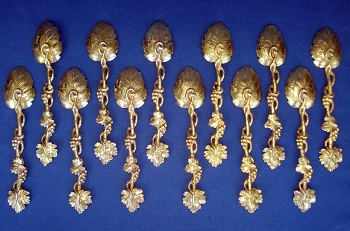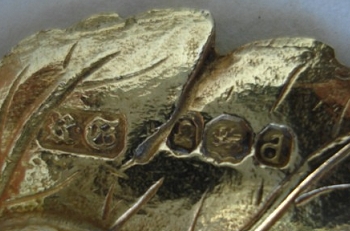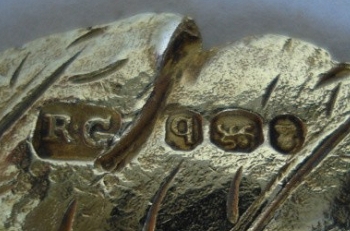Robert Garrard II (1793 - 1881)
Biography
A set of 6 silver-gilt naturalistic teaspoons and a pair of tea tongs was made by a famous crown jweller Robert Garrard II, London, in 1854. Robert Garrard II was apprenticed in 1809 to his father, Robert Garrard I, a partner of Wakelin and Company, and gained his freedom of the Grocers' Company by patrimony in 1816. After the death of his father in 1818, Garrard entered his mark and, with his brothers James and Sebastian, took over the management of the workshop.
During the early nineteenth century, the firm's business expanded at a tremendous rate, especially after the joining of Rundel, Bridge and Rundell in the 1820s. A large design studio was set up by them, which was modelled on that developed by Rundel, Bridge and Rundell and employed several well-known painters and sculptors, including Edmund Cotterill. During the mid-nineteenth century, Garrard's was one of the leading producers of elaborate presentation silver.
In 1830, the Garrards were appointed goldsmiths and jewellers to the king and in 1843 official crown jewellers.
Garrard & Co
Garrard & Co (formerly Asprey & Garrard) is a luxury jewellery and silver company founded by George Wickes in London in 1735. Its current base is at Albemarle Street in London, its USA flagship store is in Beverly Hills. The company also has presences in Tokyo, New York, Osaka, Dubai, Moscow and Hong Kong. It was the Crown Jeweller of the UK, charged with the upkeep of the British Crown Jewels, from 1843 to 2007.
History
 Coronation Chair and Regalia of EnglandThe company that was to become Garrard was founded by George Wickes (1698–1761), who entered his mark in Goldsmiths' Hall in 1722. Wickes set up business in Threadneedle Street in the City of London in 1722; the company moved to Panton Street off Haymarket in central London in 1735 as a goldsmith and provider of jewellery and other luxury items to aristocratic patrons.
Coronation Chair and Regalia of EnglandThe company that was to become Garrard was founded by George Wickes (1698–1761), who entered his mark in Goldsmiths' Hall in 1722. Wickes set up business in Threadneedle Street in the City of London in 1722; the company moved to Panton Street off Haymarket in central London in 1735 as a goldsmith and provider of jewellery and other luxury items to aristocratic patrons.
Wickes was an accomplished silversmith known for his work in the rococo style, and gained the patronage of Frederick, Prince of Wales. Two apprentices of Wickes, John Parker and Edward Wakelin, purchased the company following Wickes' retirement in 1760, replaced by John Wakelin and William Taylor in 1776. Following the death of William Taylor, Robert Garrard I became a partner in the company in 1792.
Robert Garrard I took sole control of the firm in 1802, with his sons Robert Garrard II (1793 - 1881), James and Sebastian succeeding him in running the company, trading as R., J., & S. Garrard (or Robert Garrard & Brothers) until James’ retirement in 1835, when the company became R & S Garrard. The company remained in the hands of the Garrard family until the death of Sebastian Henry Garrard, great-grandson of Robert Garrard senior, in 1946.
The name Garrard & Company Ltd was registered in 1909, and the company moved to new premises in Albemarle Street in central London in 1911.
In 1915, Garrard & Company were asked to manufacture precision range finders for the British Artillery as they had both the craftsmen and machinery needed. In 1915, the Garrard Engineering and Manufacturing Company was created, and later became known for its phonograph turntables, ceasing operations in 1992.
Crown Jeweller
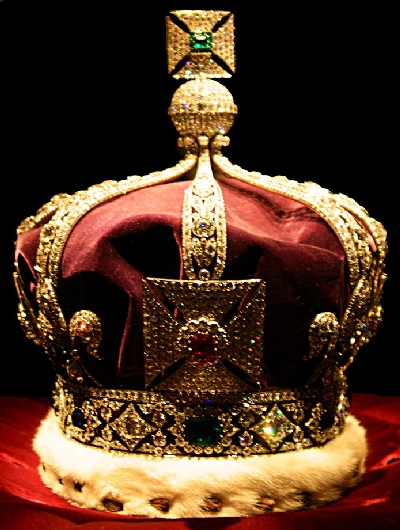 Imperial Crown of IndiaSince 1843, when Queen Victoria bestowed the honour of Crown Jeweller on the company, Garrard has served six successive monarchs, leading to the production of numerous pieces of silverware and jewellery for the Royal Family, as well as the upkeep of the Crown Jewels.
Imperial Crown of IndiaSince 1843, when Queen Victoria bestowed the honour of Crown Jeweller on the company, Garrard has served six successive monarchs, leading to the production of numerous pieces of silverware and jewellery for the Royal Family, as well as the upkeep of the Crown Jewels.
The company has dealt with a number of famous jewels, such as the Cullinan diamonds (including Cullinan I, "The Great Star of Africa"). In 1852, Garrard were given the responsibility of re-cutting the famous Koh-i-Noor diamond into a brilliant.
In 1911 two important commissions were undertaken: the making of Queen Mary's Crown for the Coronation; and, the Imperial Crown of India worn by King George V later that year, at the Delhi Durbar. The Coronation of 1937 heralded another important occasion for the royal jewellers. When the crown set with the Koh-i-Noor diamond was made for the late Queen Elizabeth, The Queen Mother. The Imperial State Crown was remounted by Garrard in 1937, and then further adjusted for H.M. The Queen for the Coronation in 1953.
Garrard is particularly acknowledged for its role in connection with H.M. Tower of London. On display in the Jewel House are the most important jewels in the United Kingdom and it is an honour for Garrard to be associated with this collection.
Ceremony and pageantry has always been a key element in the company's heritage as well as the association with great sporting events. Spectacular trophies and centrepieces display excellent examples of superb silver craftsmanship. Robert Garrard's hallmark of 1848 is found on the well-known America's Cup. Lavish hunt and horse racing testimonials in full Victorian splendour became a Garrard speciality. For modern day sports enthusiasts other presentation trophies include; the Dubai World Cup, the Cricket World Cup, the Premier League Trophy.
Recent History
Garrard merged with the jewellery firm Asprey in 1998 to become Asprey & Garrard, moving from 112 Regent Street to premises on New Bond Street. Asprey & Garrard was bought by Prince Jefri Bolkiah, a younger brother of the Sultan of Brunei, in 1995 for £243m, and later acquired by private investors Lawrence Stroll and Silas Chou for an undisclosed sum in 2000.
The company demerged in 2002, with Garrard returning to the Albemarle Street site it first occupied in 1911. Garrard was acquired by the US private equity firm Yucaipa Cos. in 2006, ending its partnership with Asprey. Jade Jagger became the creative director for the company in 2002.
The current "crown and G" logo is based on Robert Garrard II 's 1822 hallmark.
On 15 July 2007 an announcement was made in the Court Circular, under Buckingham Palace, that Garrard & Co's services as crown jeweller were no longer required, with the reason cited being that it was simply 'time for a change'.
Kentbased Harry Collins (G. Collins and Sons) were appointed the new Crown Jewellers.
Garrard & Co official web site and Wikipedia
Works of Arts - Garrard
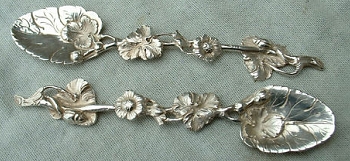 Naturalistic teaspoons made by Robert Garrard II, London, in 1817. Naturalistic teaspoons made by Robert Garrard II, London, in 1817. |  Naturalistic teaspoons made by Robert Garrard II, London, in 1817. Naturalistic teaspoons made by Robert Garrard II, London, in 1817. |
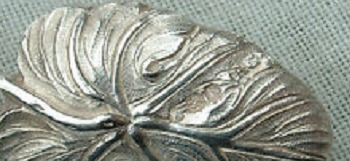 Naturalistic teaspoons made by Robert Garrard II, London, in 1817. Naturalistic teaspoons made by Robert Garrard II, London, in 1817. |
 Top
Top Site Map
Site Map References
References About Me
About Me
